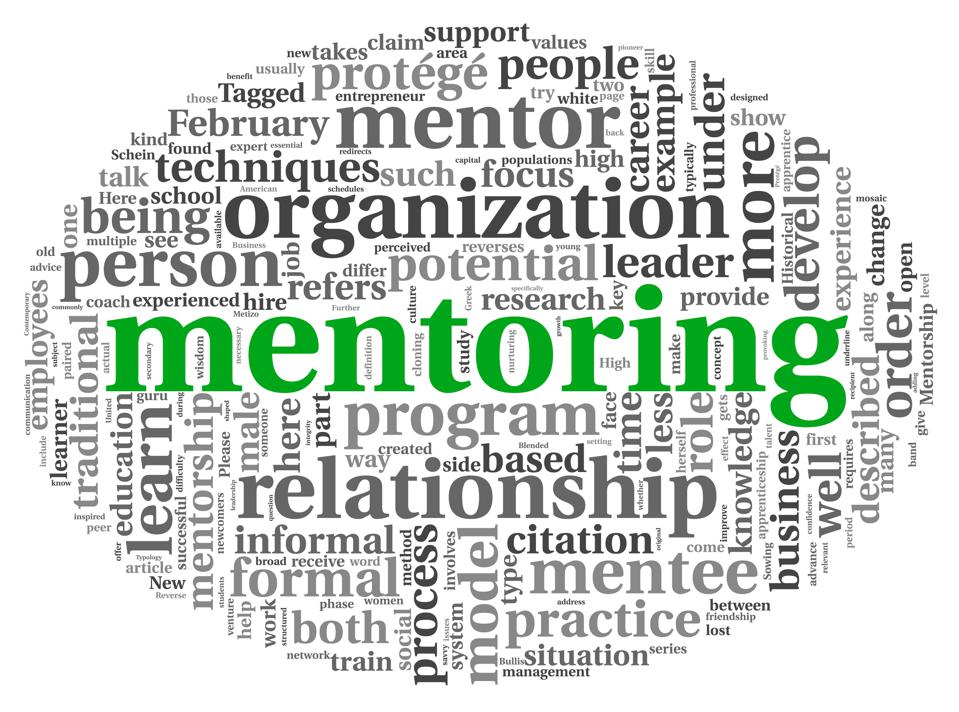Get ready president
| Site: | Rotary District 9675 My Learning |
| Course: | Presidents' Elect Example |
| Book: | Get ready president |
| Printed by: | Guest user |
| Date: | Thursday, 20 November 2025, 10:54 PM |
1. Overview
Congratulations on your position as club president. Use this resource to learn more about your role before you attend the presidents-elect learning and development seminar and district training assembly. The Club President Basics course in the Learning Center can also help you prepare.
As a member of Rotary’s global network of more than 34,000 clubs, you have access to a wealth of services and resources available through My Rotary. You’ll find information, resources, club data, and the Grant Center, where you’ll apply for and manage Rotary grants to carry out effective and sustainable projects.
You’ll also get support from Rotary staff. To start using My Rotary, create your account.
As a president elect it is your role to prepare for your year, inspire members and promote Rotary in your community:
- Consult the club president on the current status of the club
- Serve as a director of your club’s board
- Appoint committee chairs and a trainer for your year (responsibility is indicated in the Rotary Code of Policies)
- Supervise preparation of the club budget
- Encourage incoming club officers to attend the district training assembly
- Create an account on My Rotary
- Attend your presidents-elect learning and development (PELD) workshop, district training assembly, and district conference
- Set and track goals for your club in Rotary Club Central on My Rotary
- Ensure all club officers are reported on My Rotary so they can receive important communications from Rotary International. Please note: If you keep your information up to date in your ClubRunner site or the District website (also a ClubRunner platform) all of the information is automatically updated in MyRotary. It does not work the other way ie. updating information in MyRotary does not update the District website or you ClubRunner site).

2. Planning your year
Citation goals
Your club can earn a Rotary Citation for achieving goals that strengthen Rotary and your club. Goals include increasing club membership, developing sustainable service projects, giving to The Rotary Foundation, and building awareness of Rotary in your community.
The Rotary Citation does vary a little from year to year depending on the priorities of the Rotary International President. This year your club must achieve at least 13 out of the 25 Citation Goals. This flexibility allows clubs to choose the goals that are most relevant and achievable.
Citation goals can be found in Rotary Club Central.
The Citation Goals can be used by clubs as the basis for setting goals and are an excellent tool to assist in preparing plans and goals for the upcoming year.
Strategic planning
- Start early (now).
- Develop/evaluate your club’s strategic plan to ensure that
it is current & relevant.
- Review your club’s strengths & weaknesses and identify
opportunities and challenges in your community (Rotary Club Health Check).
- Develop a vision – what do you want your club to look like?
- Develop annual goals to support the long-term goals in your
strategic plan (Rotary Club Central).
- Goals need to be SMART (specific, measurable, attainable,
realistic, time-specific).
- Create an action plan for each goal.
- Develop your goals together with your leadership team.
- Have separate goals for each Board portfolio.
- Share goals with club members and motivate them to achieve your goals.
- Monitor your progress and adjust goals if necessary.
- Celebrate achievements.
Most importantly, be ready to get started on 1st July.
Excellent resources for strategic planning include Rotary Club Health Check, the Rotary ‘’Strategic Planning Guide’’ and ‘’Lead Your Club – President 2019-2022’’.
Short & long term goals
- When you have set your strategic priorities (long-term
goals) you can then develop yearly (short-term) goals that support them.
- Write down your strategic priorities then list your annual
goals along with the actions you will take, the resources you will need and who
will lead the effort to meet each goal.
- Set a timeline for each goal.
- Short-term (annual goals) should be completed with the
Rotary year.
- Long-term goals are the pillars of your strategic plan and consist of many smaller short-term goals.

3. Leading your club
During your year as club president, you’ll provide the vision to tackle social issues in your community, and the leadership to strengthen your club as it joins with Rotary in addressing the world’s toughest challenges. Take advantage of your members’ expertise and your community’s resources to carry out this work. Find support from your district leaders and Rotary International on topics including public relations, membership development, and more.
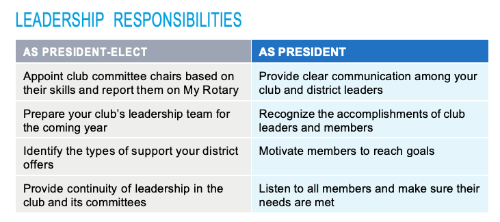
3.1. Working with your team
Your club leadership team (Club Board) includes club board members as well as the club trainer, sergeant-at-arms, and committee chairs. Be sure your club has committees that meet its needs. To find out more about Committee structures etc go to Club management>>Board responsibilities.
Encourage club leaders to attend district training meetings to prepare for their roles and access the information under Club Management in MyLearning.
The board is elected to manage the interests of the club as a whole and to work closely with you to achieve club goals. You are responsible for running regular club board meetings. Based on the Recommended Rotary Club Bylaws, your club’s board of directors has these responsibilities:
- Oversee the work of all club officers and committee members
- Review the monthly report of club finances to make sure the budget includes realistic amounts for club operations and projects. Also to a
pprove all expenditures not accounted for in the club budget
- Approve or reject proposed and other prospective members, including online membership leads, and communicate the decision to those who proposed the members, and to the membership candidates, within 30 days (club secretary
communicates with the proposer)
- Review club policies in your club bylaws to ensure they are being implemented as intended, and revise them if they are no longer current
- Consider innovative ways to make the club more flexible, vibrant, attractive to new members, and engaging to current members
- Explore the needs of your community and international communities to establish club goals.
It is also important that you plan ahead and identify who will be following you as president so you can work with them to ensure continuity in your leadership team.
Think about the following issues
How will you strengthen your relationships with your club leadership team?
How will you develop future leaders?
What ideas do you have working with your assistant governor and governor?

3.2. Communication
As a president one of the most important skills you have is the ability to communication effectively. Watch the following 10 minute video and think about how you communicate and how you may improve.
Summarising what Celeste Headlee was saying in her talk about effective communication:
- Don't multitask
- Don't pontificate
- Use open ended questions
- Go with the flow
- If you don't know, say that you don't know.
- Don't equate your experience with theirs.
- Try not to repeat yourself.
- Stay out of the weeds.
- Listen.
- Be brief.
Think about your style of communication. How might you improve how you communicate?
3.3. Tricky situations
As a president you will find that there will be times that there is conflict amongst club members or within the organisation. There is aways help available from your mentor, and/or your assistant governor. They can help you find a solution or rally extra supports.
One of the first steps is to gain insight into conflict and how you might identify the issues causing the conflict. Watch the following video and reflect on whether these strategies could help you in a difficult situation.
Liz Kislik discussed the steps to conflict resolution as being:
- Identify if there is a person who may be causing the conflict such as a bully and deal with them
- Ask the right people the right questions to identify the issues causing the conflict
- Ensure you get an alignment around goals the issue amongst those involved
- Find allies for the solution amongst club members.
- Talk to those involved on ways to manage differences.
3.4. Motivation and recognition
An important part of your role is to motivate club members to learn about Rotary, get excited about Rotary’s work, and take action to achieve goals. Like you, club members are volunteers who value their time. Keep expectations reasonable and show appreciation for their efforts. Find out what motivates each member of your club to get involved.
Common motivators:
- belief that club goals/projects benefit the community and club and that goals are achievable
- social opportunities to connect with others
- career networking opportunities
- setting milestones and reporting on the milestones to show progress
- recognition of individual and team efforts.
Regularly assess if the motivators are working and make changes as needed.
One way to show appreciation for your members’ commitment is to recognise them with awards such as the Service Above Self Award, Rotary Foundation Distinguished Service Award, Service Award for a Polio-Free World, and Avenues of Service Citation. See the Awards page on My Rotary to learn more about these and other honours.
Make recognition events inspiring and motivational by:
- Inviting the governor to present the award
- Inviting family members to attend
- Photographing the presentation and sharing the images on your club website and social media
- Inviting prospective members
Your district may have its own awards for clubs or individuals; ask your governor or assistant governor. Individual clubs are encouraged to develop their own awards too.
How will you motivate members to achieve goals?
4. Running meetings effectively
Meetings which are planned and well-run will continue to engage members and provide them with meaningful and enjoyable experiences. Think about why members come along to regular Rotary meetings - it is for communication (a two-way process, not just the President imparting ideas and facts); fellowship between members (so make sure you allow time at meetings for this); listening to interesting and entertaining guest speakers. You want members to enjoy coming along to Rotary meetings and you, as President, can do a lot to enable this to happen.
There are different types of meetings, including:
We will look at these separately but the most important thing for each meeting is to be prepared.
4.1. Guest Speakers
Having a guest speaker at meetings is a great way to motivate members, an opportunity for everyone to learn something new and also to recognise what the guest speaker is doing in the community.
Before the meeting:
- Ensure the guest speaker and you/the club is aware of the topic.
- Ensure the guest speaker is aware of the length of time available to him/her.
- Find out if the guest speaker requires anything at the meeting for the presentation, eg. if presenting anything digitally, will he/she bring a laptop or do you need to have one with you? Be prepared!
- Most guest speakers will anticipate questions from the audience, however, it’s a good idea to check with the guest speaker prior to inviting questions.
- Think about the time the guest speaker will start. Different options will suit different guest speakers and different clubs – the thing is for you, as President, to consider it and work with the guest speaker to decide what is best for the guest speaker and your club.
- As president, personally meet and greet the guest speaker.
- Organise with a member to look after the guest speaker, show him/her to his/her chair, assist with dinner order (if appropriate) and to generally converse with the guest speaker.
- Ensure the guest speaker is seated in a position where he/she can see the majority of the people in the room.
- Include the guest speaker’s name in your general welcome to the meeting.
- Organise for a member to formally introduce the guest speaker to the meeting when it is time for their speech.
- Invite questions from the meeting, if agreed to prior with the guest speaker.
- Organise with another member to give a vote of thanks after the speech.
- Present the guest speaker with a small gift, if that is the tradition in your Club.
4.2. General Points about Communication
You may, as President, feel very confident about speaking in public and leading meetings.
There are many courses on communication on the Rotary International site that you can do if you wish. You can also speak to a trusted friend after the meeting, particularly in the beginning of your presidency, and ask for feedback that you can then incorporate into future meetings you lead.Some questions you might ask:
- Be prepared!
- If you have a lectern at your Rotary meeting, keep a copy of the agenda there. This is very handy for any other member who is going to talk at the meeting (they should also know prior to the meeting if they are going to give a report).
- Display your banner on the lectern (or elsewhere in the meeting room).
- Check that the microphone works (if appropriate)
- Start on time.
- Stand up when talking to the meeting.
- Do not lean on the lectern.
- Maintain eye contact and look around the room to interact with and involve all people in the room.
- Speak in a friendly manner.
- Communicate clearly.
- Make everyone feel welcome.
- Stick to the agenda!
- Finish on time.
- If there are members who are hearing-impaired, can they hear the speakers?
- Be mindful of the way you and others speak.
- If a ‘discussion’ between members becomes acrimonious, you, as president, should step in before the issue escalates. It is important that each member feels they can be heard, however, at Rotary we expect people to talk respectfully to each other.
- Be mindful of adherence to policies, including: Anti-Bullying and Harassment; Privacy; Anti-Discrimination; Diversity, Equity and Inclusion.
- You should talk privately with any member whose behaviour, attitude or language is of concern. Do not get involved in this publicly in a meeting. Consult your Assistant Governor if you need further advice or simply just to discuss with him/her.
- Be inclusive of all members and guests.
- Show appreciation and recognition to members of the Club. Acknowledge which members have been involved in different activities.
4.3. Regular Club Meetings

- Be prepared!
- Have a written agenda.
- Display your banner on the lectern (or elsewhere in the meeting room). Some Clubs also display the Chain of Office on the lectern.
- Consider having club members rostered as greeters – to meet and greet people as they come to the meeting.
- Start on time. Get the sergeant at arms to ring the bell as the starting time (if appropriate to your club).
- Discuss prior to the meeting with Directors if they wish to give a report and put it on the agenda. Avoid calling out names of Board members at the meeting and asking if they have a report to give.
- Have an item on the agenda called ‘Any other matters that members wish to raise’. This is a way to ensure that all members feel they can raise matters at the meeting. It may be that the matter needs further discussion, in which case you can say so.
- Include information on what will be happening in Rotary in the next couple of weeks.
- Finish on time.
4.4. Board Meetings
The Board is elected
to manage the interests of the club as a whole and to work closely with you to
achieve club goals. Your job, as President, is to plan
and lead Board meetings. These should be held monthly or as per Club By-Laws.
- Circulate the minutes and actions from the previous meeting soon after the meeting
- Develop the agenda with the secretary and ask members of the Board for agenda items
- Agendas should include a review of the monthly report of club finances and approve all expenditures not accounted for in the club budget
- Allow enough time to address all items on the agenda
- Hold a special Board meeting if there are issues that need to be addressed between meetings
- Make sure you have a quorum as per your Bylaws
- Approve or reject proposed members and communicate the decision to those who proposed the members, and to the membership candidates, within 30 days (club secretary communicates with the proposer)
- Review club policies in your Club By-laws to ensure they are being implemented as intended, and revise them if they are no longer current
- Consider innovative ways to make the club more flexible, vibrant, attractive to new members, and engaging to current members
- Explore the needs of your community and international communities to establish club goals
Near the end of your Rotary year, organise a joint meeting of the incoming Board of Directors with the outgoing Board.
4.5. Club Assemblies
Club assemblies are an opportunity to exchange ideas and share information about issues that are important to your members.
As with all meetings, have a written agenda and be prepared.
A club should hold 4-6 club assemblies per year.
Encourage all members to attend as everyone’s ideas and input are important.
The
president should generally lead the club assembly.
Seek
member input to make sure that their interests and concerns are being addressed.
4.6. DG's visit
District Governor visits are important to your club. The DG may visit your Club separately or it may be a combined meeting with other nearby Clubs.
The DG will:
- Provide support and guidance
- Update clubs and members on District activities and goals
- Motivate members to achieve club goals
- Provide an opportunity for your club to discuss your goals, achievements and concerns
In preparation for the District Governor’s visit:
4.7. AG's visits
Get to know your Assistant Governor. They are there to support you and your club and keep you in touch with what is happening at District level and Rotary International. Your club is autonomous but is also part of the wonderful Rotary organisation.
- Your Assistant Governor should
visit at least 4 times in the Rotary year. You may like to invite them to
a Board meeting so they can get an idea of your programs/projects
- Invite them to present on what is
happening at District level and any major events in Rotary International.
- When they attend you should
fund their meal if the meeting is a dinner/lunch/breakfast meeting.
- Make them feel welcome. They are
there to support you and can often add an independent point of view in
difficult situations.
- Include your AG in the meeting and always provide them with an opportunity to address the meeting.
4.8. AGM
The Annual General Meeting (AGM) should be held within 6 months of the end of the financial year (ie. by 31st December). Ensure you have a quorum - check your By-Laws.
The AGM agenda should include:
- The adoption of Minutes of the previous AGM
- The election of Officers
- Approval of audited accounts from the previous year:
- For Clubs that generate an income of more than $250,000 per year this is mandatory
- For Clubs who generate less than $250,000 per year the financial records can be reviewed by two club members who have a background in finance, however, many clubs still choose to undertake an external audit as accepted best practice
- Lodge an annual statement by the Public Officer with the Department of Fair Trading within one month after AGM
- Time period to notify members of the AGM is 21 days.
At the AGM your Board for the following year should be elected:
- All positions on your Board. The president's position must change yearly except in exceptional circumstances then the president may continue for a period of 18 months.
- Members nominate candidates for President, Vice President, Secretary, Treasurer, and any open Director positions. The nominations may be presented by a nominating committee, by members from the floor, or both.
- A nominated person from the Club can be the returning officer if there is more than one nomination. Usually the returning office is the Club secretary.
- Communication of the results is via circulation of the minutes from the meeting and Club Bulletin.
4.9. Online and hybrid meetings
In today’s world due to the current situation with Covid 19 and social isolation many clubs are turning to web conferencing to continue to engage in meetings and to undertake club business.
There are other reasons, however, as online meetings can save time and travel. Good advice is to also look at hybrid meetings: face-to-face meetings for those members who can attend but with an option for those who cannot be there in person to join the meeting online.
A few protocols for online meetings:
- Stick to your usual meeting basics, ie. have a written agenda and be prepared.
- Set ground rules, such as everyone turns off the microphone unless speaking.
- If you, as President, are not comfortable with the technology, seek out a member who can advise on aspects such as setting up break-out rooms, recording the meeting, requesting control, sharing the screen, using the whiteboard, polls, etc.
- Consider fellowship that occurs at face-to-face meetings. How will you incorporate fellowship time into your online meeting?
- Log on early and test your audio.
5. Running your club
Your role as President is to lead the Club, however, you are supported by Board and general members of your club, as well as by your District Officers. The President should have an overview of everything that occurs in a Club.
District 9675 has developed a Club Governance Checklist to guide clubs. The checklist is divided into the following categories:
- Accounts and Finance
- Budgets
- Insurances
- Legal Compliance
- Membership
- Risk Management
- Rotary Compliance
- Strategic Planning
- Succession Planning
- Working with Children
Use this checklist as the 'go to' document.
Click on the checklist below to determine what is the current state of play in your club and work through the checklist to achieve all details of governance mentioned.
6. Strengthening your membership
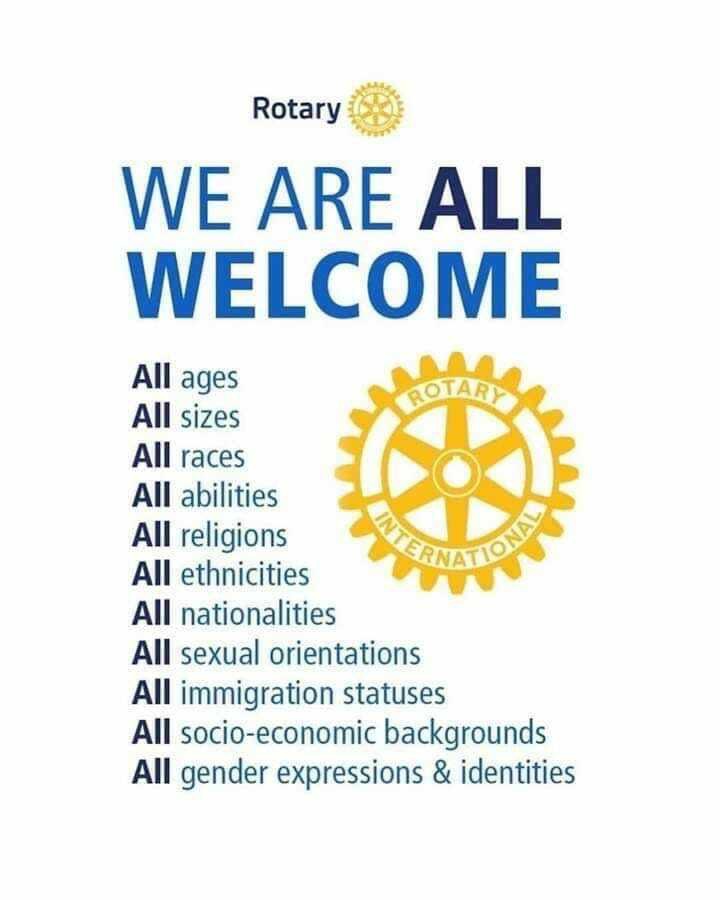 Engaged and active club members make
it possible to serve communities at home and around the world, to support the work of The Rotary Foundation, and to develop future leaders. But most of all, engaged and active members make your club a fun place for all members
Engaged and active club members make
it possible to serve communities at home and around the world, to support the work of The Rotary Foundation, and to develop future leaders. But most of all, engaged and active members make your club a fun place for all members
Make certain that your membership reflects the diverse professions and cultures of your community. A diverse membership not only attracts potential candidates, it also promotes innovation and provides the skills and experience your club needs to make positive changes in your community.
Club membership committee
The committee’s main role is to attract, engage, and educate club members. Your club may amend its bylaws to reflect the specific responsibilities of your membership committee, adding subcommittees as needed.
Once you’ve evaluated your club’s membership trends and drafted membership goals, enter them into Rotary Club Central and develop an action plan for achieving them.
New members can bring new vitality to your club, fresh ideas and energy, increased capacity to serve your community, and potential future leaders, all of which can help ensure your club’s long-term success.
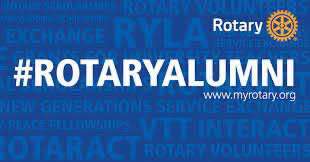 Members who are engaged are dedicated, active, and motivated. Engaged members will make your club activities more fun and effective. They are also more likely to invite prospective members to join.
Members who are engaged are dedicated, active, and motivated. Engaged members will make your club activities more fun and effective. They are also more likely to invite prospective members to join.
Your club has a valuable asset in the thousands of Rotary alumni who’ve participated in a Rotary program. They are powerful advocates for Rotary as well as potential members and donors.
Membership Goals
Before setting membership goals, work closely with your club’s membership committee to assess your club. The Club Membership Committee Checklist is a good place to start. The checklist contains links to valuable Assessment Tools to assist the committee to analyse your membership. It also ensures you are are implementing your membership plan.
Once you’ve evaluated your club’s membership trends and drafted membership goals, enter them into Rotary Club Central and develop an action plan for achieving them.
7. Promoting Rotary
Public understanding of who we are, what we do, and the value we bring to communities has never been more important. No other organisation is quite like Rotary. If we speak, write, and design in one voice, our communications will sound, read, and look unmistakably like Rotary.You can find out more about the Rotary Brand and access materials and resources on the Rotary Brand Center

7.1. Rotary as a brand
 A brand is more than
a logo. Rotary’s brand is much bigger than its wheel. It’s a perception: it’s how others think about us, not just how we see ourselves. The following guidelines are really handy when developing promotional materials. Identity at a glance
A brand is more than
a logo. Rotary’s brand is much bigger than its wheel. It’s a perception: it’s how others think about us, not just how we see ourselves. The following guidelines are really handy when developing promotional materials. Identity at a glance
When mentioning the Rotary brand, we are referring to the basic qualities and goals that unite all Rotary clubs and districts — it’s what we offer people who partner with us, join a club, or participate in our programs and projects. Our brand reflects our identity, our vision, and our essence, as well as our values. It represents our unique culture and our approach to creating lasting, positive change.
People’s perception of Rotary comes from their experiences with our clubs and programs, along with the stories we tell and the images we share. Compelling, consistent brand communications — together with a great experience — can strengthen our brand and help us engage and attract more members, donors, and partners.
If you are unsure always ask for advice and assistance. For example your Assistant Governor.
8. The Rotary Foundation
The Rotary Foundation transforms your gifts into service projects that change lives both close to home and around the world.
The Rotary Foundation helps Rotarians to advance world understanding, goodwill, and peace by improving health, providing quality education, improving the environment, and alleviating poverty.
Since it was founded more than 100 years ago, the Foundation has spent more than $4 billion on life-changing, sustainable projects.
With your help, we can make lives better in your community and around the world. The money you and your Club donates do support the Foundation but then some comes back to your Club through District Grants.
What impact can one donation have?
- For as little as 60 cents, a child can be protected from polio.
- $50 can provide clean water to help fight waterborne illness.
- $500 can launch an antibullying campaign and create a safe environment for children.
9. Your projects
 The top two reasons people join Rotary are to give back to their local community and to connect with friends. A successful service project can do both! By working together, Rotary members and the community develop lasting friendships as your club makes a real difference in the world.It is important to Identify an issue that takes advantage of your members’ skills, builds effective networks, and involves community members as partners. When your Rotary club takes action, you’ll engage your club’s members and show your community how Rotary creates positive change.
The top two reasons people join Rotary are to give back to their local community and to connect with friends. A successful service project can do both! By working together, Rotary members and the community develop lasting friendships as your club makes a real difference in the world.It is important to Identify an issue that takes advantage of your members’ skills, builds effective networks, and involves community members as partners. When your Rotary club takes action, you’ll engage your club’s members and show your community how Rotary creates positive change.
What is your role in planning projects?
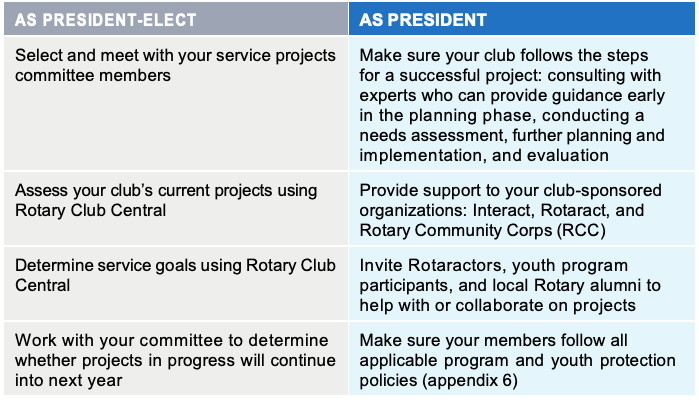
How do get you get started on a project?
- Form a service projects committee.
- Work with the committee to assess ;community needs, determine how best to address it, and understand available resources.
- Need ideas - go to Rotary Showcase to see what other clubs have done.
- When planning projects, both local and international, use club, district, and Rotary resources such as Rotary Ideas and Lifecycle of a Project.
- Consult with district community service chairs on project ideas and identify resources.
- Collaborate with your district international service chair to connect with local experts for assistance with club-led projects.
- Work with the club public image committee to promote projects.
- Carry out projects and involve all members.
Rotary Grants and Projects
Rotary offers grants that support a wide variety of projects, scholarships, and vocational training opportunities led by Rotarians around the world.
District Grants
District grants fund smaller, short-term activities — including humanitarian projects, scholarships, and vocational training teams — that address needs in your community and communities abroad.
Global Grants
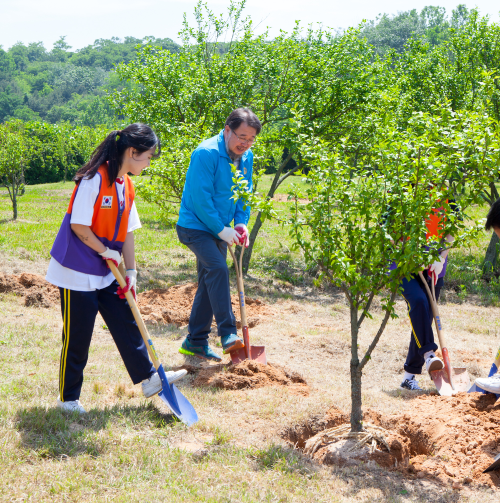 Global grants
support large international activities with sustainable, measurable outcomes in Rotary’s areas of focus.
Global grants
support large international activities with sustainable, measurable outcomes in Rotary’s areas of focus. These grants fund humanitarian projects, vocational training teams, and graduate and postgraduate scholarships. To participate in global grants, your club will need to find an international partner. Talk to the Director International Projects to find out more.
10. Having a mentor
Rotary is a complex organisation due to its size and multiple projects and functions.
A mentor can support you and guide you so that you can realise the full benefits of belonging to this amazing organisation and being a president, even if this is not your first time.
A mentor will share knowledge, skills, and life experience to guide you; it is a journey of shared discovery. So we encourage you to find a mentor for your year as president.
